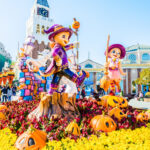South Korea is a traveler’s paradise waiting to be explored. From bustling cities to serene temples, and from lush national parks to futuristic museums, It offers a diverse range of attractions for every kind of traveler. There is everything you may want in one country. Here, we will delve into 20 must-visit places in South Korea, providing you with a detailed glimpse of what makes each location special. I promise if you are visiting just one country and that’s South Korea you will not regret it.
- Seoul – The Capital City
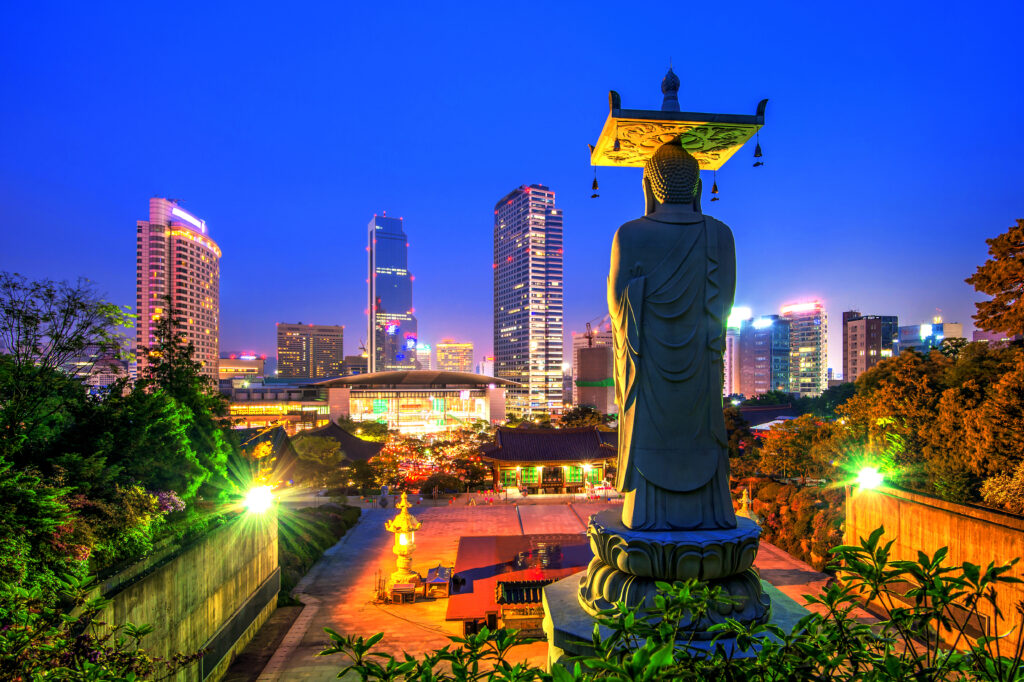
Bongeunsa Temple in Seoul, Korea.
Seoul, the capital city of South Korea, is a vibrant metropolis that seamlessly blends its rich history with modernity. From ancient palaces and traditional markets to futuristic skyscrapers and trendy neighborhoods, there’s no shortage of things to explore in this dynamic city. Here are some of the top attractions and experiences to consider when visiting Seoul:
Gyeongbokgung Palace: Start your journey by visiting one of Seoul’s grand palaces, Gyeongbokgung. You will be amazed how the journey of you starts. This historic palace is a symbol of South Korea and offers a glimpse into the country’s royal history. Don’t miss the Royal Guard Changing Ceremony that takes place in front of the main gate. This is their main attraction there.
Bukchon Hanok Village: Located near Gyeongbokgung Palace, this traditional village preserves the charm of ancient Korea. And who doesn’t love a beautiful village. Stroll through its narrow alleys lined with beautifully restored hanok (traditional Korean houses) and experience the serenity of old Seoul. Your soul will find peace there. Soak in all the calmness before you jump into the crazy world.
Myeongdong: A shopping paradise, Myeongdong is famous for its vibrant street markets, luxury boutiques, and Korean beauty product stores. It’s a great place to shop for fashion, cosmetics, and street food. For a shopaholic like me it’s a dream come true. You can splurge on some good Korean cosmetics too.
Dongdaemun Design Plaza (DDP): Designed by the renowned architect Zaha Hadid, DDP is an iconic landmark known for its futuristic architecture. It hosts various exhibitions, fashion events, and is beautifully lit up at night. If you have fascination with architecture then this is a must visit.
Namsan Seoul Tower: Head to Namsan Mountain to reach the iconic Namsan Seoul Tower. You can hike up the mountain or take the cable car. The tower offers breathtaking panoramic views of the city and is especially romantic at sunset. Those who are there for a honeymoon will have an amazing time there. Insadong: Immerse yourself in Korean culture by visiting Insadong, a neighborhood filled with traditional teahouses, art galleries, and antique shops. It’s an excellent place to pick up souvenirs and experience traditional Korean crafts. Its something that stays with you forever and reminds you of the great time you had.
Changdeokgung Palace and Secret Garden: Another stunning palace, Changdeokgung, is famous for its beautiful secret garden. You can join a guided tour to explore this UNESCO World Heritage Site. This is also architecture lover’s paradise. Its amazing how they harmonized natural beauty and architecture together.
Gangnam District: Made famous by the song “Gangnam Style,” this district is a hub of upscale shopping, dining, and entertainment. Explore the bustling streets and see the affluent side of Seoul. If you were a fan of this song go to have a real time experience there.
Korean Street Food: you go to Korea and not have their street food? That’s blasphemous almost. Seoul is a food lover’s paradise. Be sure to try street food classics like tteokbokki (spicy rice cakes), kimbap (seaweed rice rolls), and hotteok (sweet pancakes) at various street stalls and markets. There are new kind of food frenzy going on all the season. Grab whatever you find at that time and you will be amazed.
K-pop Culture: If you’re a K-pop fan, don’t miss the opportunity to explore K-pop-related attractions like SM Town at COEX Artium and the K-Star Road in Gangnam. I don’t think I need to tell you where you should go if you are already a k pop fan. You know who you are and where to go for sure.
DMZ Tour: For a unique historical experience, consider taking a tour to the Demilitarized Zone (DMZ), which separates North and South Korea. Learn about the complex history of the Korean Peninsula and the ongoing tension. This will give a good idea about whats going on with both the country. Its purely for knowledge and sure to fascinate you.
- Busan – Coastal Beauty
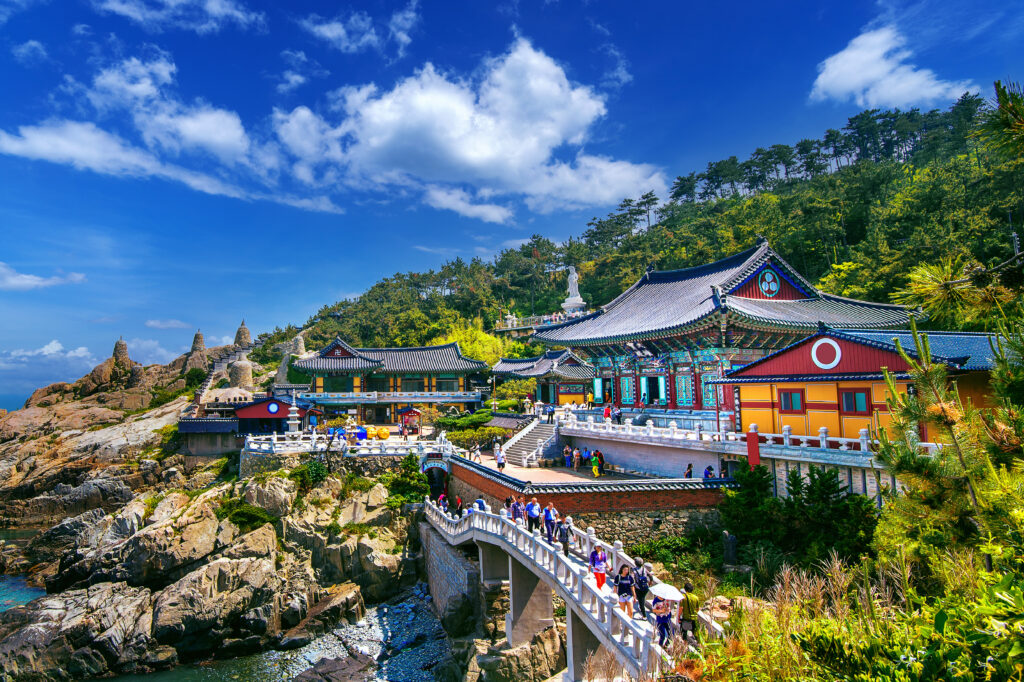
Haedong Yonggungsa Temple and Haeundae Sea in Busan, Buddhist temple in Busan, South Korea.
Busan, South Korea’s second-largest city, is a vibrant and diverse destination that offers a unique blend of traditional culture, stunning natural beauty, and modern amenities. their bustling markets, beautiful beaches are the best thing you can ever find. No matter what you are, a history buff, a beach bum, or a foodie, Busan has everything special in store for you. Here’s a guide on what you can explore in Busan:
Haeundae Beach:
Begin your Busan adventure with a visit to Haeundae Beach, one of the city’s most famous and beloved attractions. A beach lover will not feel like going anywhere other than this place. This picturesque stretch of coastline boasts soft golden sands and clear blue waters, making it the perfect place to soak up the sun, swim, or take a leisurely stroll along the promenade. The beach area also offers numerous restaurants, cafes, and shops, ensuring you won’t go hungry or bored. It can get you hooked and may not explore more places I warn you.
Gamcheon Culture Village:
Known as the “Machu Picchu of Busan,” Gamcheon Culture Village is a colorful hillside community that has become a work of art in itself. The narrow alleys are adorned with vibrant murals and sculptures, creating a whimsical and Instagram-worthy landscape. Explore the maze-like streets, visit local galleries, and interact with the friendly residents who are proud of their artistic neighborhood.
Jagalchi Fish Market:
For a taste of Busan’s maritime culture and its world-famous seafood, head to Jagalchi Fish Market. This bustling market is the largest fish market in South Korea, offering an incredible variety of freshly caught fish, shellfish, and other marine delicacies. Even if you’re not a seafood enthusiast, the lively atmosphere and the sight of merchants haggling and negotiating is a fascinating cultural experience.
Busan International Film Festival (BIFF):
If you’re a cinephile, plan your visit to coincide with the Busan International Film Festival (BIFF). Held annually in October, BIFF is one of Asia’s most prestigious film festivals, showcasing a diverse selection of international and Korean films. It’s a great opportunity to catch screenings of upcoming blockbusters and independent films alike.
Gwangalli Beach and Diamond Bridge:
Gwangalli Beach offers a more relaxed alternative to Haeundae Beach. It’s known for its stunning views of the Diamond Bridge, which comes alive with colorful lights in the evening. You can enjoy the beach during the day and then savor a romantic dinner at one of the many seafood restaurants along the beachfront, all while admiring the illuminated bridge.
Busan Tower:
For a panoramic view of the city, visit Busan Tower, situated atop Yongdusan Park. The tower offers breathtaking vistas of Busan’s skyline and the harbor. Visit in the evening to see the city’s lights come to life. The park itself is a tranquil oasis, with beautiful gardens and sculptures to explore.
- Jeju Island – Natural Wonder
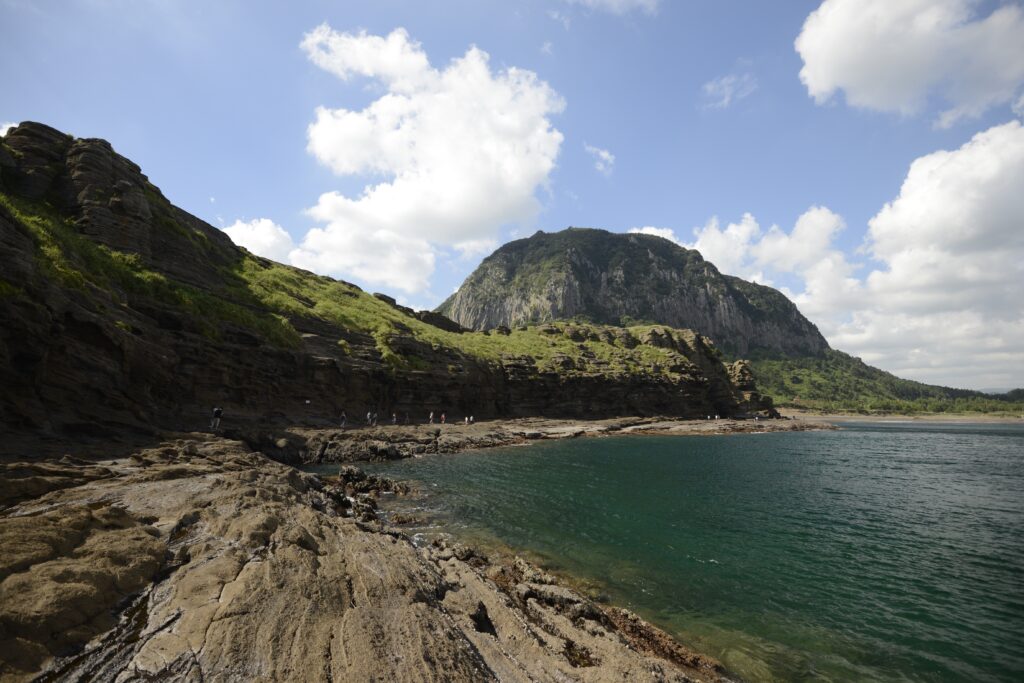
A beautiful landscape shot of large rock formations near the coast in Jeju Island, South Korea
Jeju Island, located off the southern coast of South Korea, is known for its natural beauty, unique culture, and delicious cuisine. When exploring Jeju Island, these are several specialties you should definitely try:
Haemul Pajeon (Seafood Pancake): Jeju Island is surrounded by the sea, so seafood is abundant. Haemul Pajeon is a savory pancake loaded with a variety of fresh seafood, including shrimp, squid, and green onions. It’s a popular and delicious snack or appetizer.
Jeju Tangerines: Known as “hallabong,” these sweet and juicy tangerines are a famous product of Jeju. You can enjoy them fresh or in various forms, such as tangerine juice, tangerine-flavored candies, and even tangerine ice cream.
Jeju Black Oreum Tea: This unique tea is made from a type of volcanic soil found only on Jeju Island. It has a distinct earthy flavor and is believed to have health benefits. Bring some back home to have later as well.
Jeju Chocolate: Jeju Island has several chocolate factories and shops that produce artisanal chocolates made with local ingredients. These make for great souvenirs for friends and families. And there is no sin in enjoying some yourself.
Jeju Island’s Olle Trails: While not a food specialty, the Olle Trails are a must-visit attraction for hikers. Jeju is mostly famous for food. But these place is so beautiful that it can top all the tasty food as well. These hiking trails take you through some of the most scenic parts of the island, offering views of the coastline, forests, and volcanic landscapes. That’s the best way to explore Jeju Island.
4.Gyeongju – Historical Gem
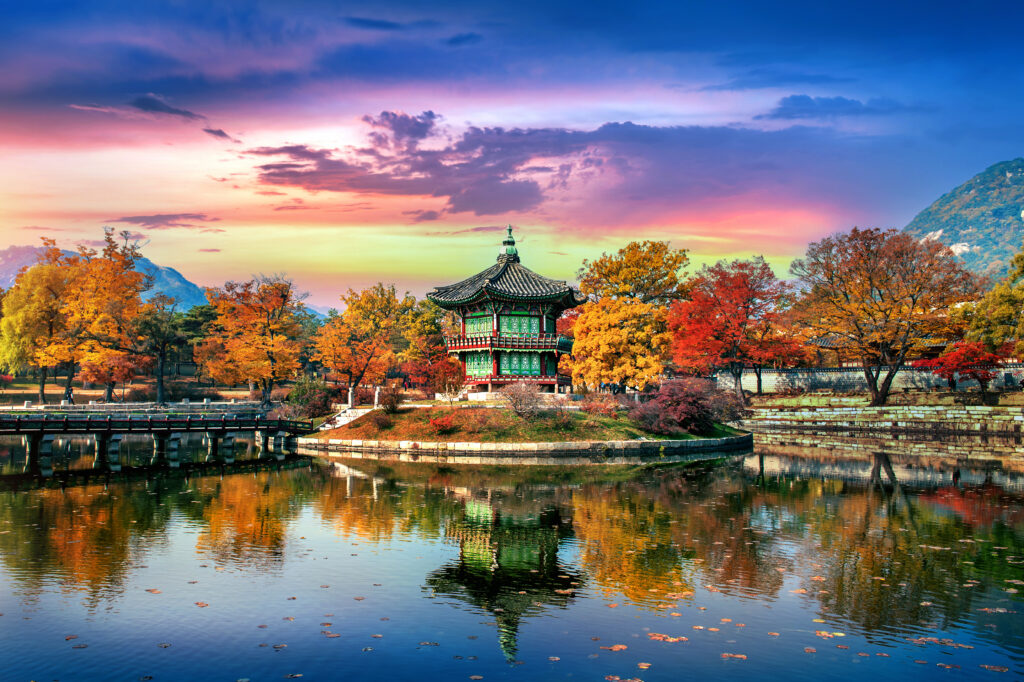
Gyeongju, often referred to as the “Museum Without Walls,” is a city located in the southeastern part of the Korean Peninsula. It holds a significant place in Korean history as it served as the capital of the ancient Silla Kingdom for nearly a thousand years, from 57 BCE to 935 CE. This long history has left Gyeongju with a rich cultural heritage and numerous historical sites, some of which are UNESCO World Heritage Sites. Here are some of the most notable historical parts you can visit of Gyeongju:
Bulguksa Temple: This Buddhist temple is one of Korea’s most iconic religious sites and is renowned for its architectural beauty and historical significance. Built in 774 during the reign of King Gyeongdeok, it is a prime example of Silla-era temple architecture. The temple complex includes various halls, pagodas, and stone sculptures, with many designated as National Treasures.
Seokguram Grotto: Located near Bulguksa Temple, Seokguram is an artificial cave temple that houses a granite statue of Buddha. This remarkable sculpture, carved in the 8th century, is considered a masterpiece of Korean Buddhist art and is a UNESCO World Heritage Site.
Anapji Pond: Anapji Pond is a historic artificial pond that dates back to the Silla period. It was originally part of the palace complex used for royal banquets and leisure activities. The pond and its surroundings have been beautifully restored, and it’s a popular place to visit, especially in the evening when it’s illuminated.
Cheomseongdae Observatory: Thought to be one of the oldest surviving astronomical observatories in East Asia, Cheomseongdae was constructed during the reign of Queen Seondeok (634-647 CE). It consists of 27 stacked stone levels, representing the 27 constellations in East Asian astronomy. It’s a testament to the advanced scientific knowledge of the Silla people.
Royal Tombs: Gyeongju is home to numerous royal tombs, known as tumuli, where Silla monarchs and nobility were buried. The most famous is the Cheonmachong Tomb (Heavenly Horse Tomb), named for the mural of a flying horse inside. These tombs are significant not only for their historical importance but also for the artifacts and insights they provide into Silla culture.
Gyeongju National Museum: This museum houses an extensive collection of artifacts and relics from the Silla Kingdom, making it an essential stop for anyone interested in the history of Gyeongju and the Korean Peninsula. The museum’s exhibits include gold crowns, pottery, jewelry, and more.
Hwangnyongsa Temple Site: Once one of the largest Buddhist temples in East Asia, Hwangnyongsa was an architectural marvel during its time, reaching nine stories high. While the temple itself no longer exists, its foundations and some relics can be seen at the site.
- Incheon – Gateway to Korea
Incheon is a vibrant city in South Korea known for its rich history, modern amenities, and cultural attractions. Here are some of the best places to visit in Incheon:
Incheon Chinatown: Incheon’s Chinatown is one of the largest and most well-preserved in South Korea. It’s a colorful and bustling area with a variety of restaurants, shops, and cultural sites. Don’t forget to try the delicious Chinese-Korean fusion cuisine.
Incheon Grand Park: This expansive park is a great place to relax and enjoy nature. It features beautiful gardens, walking trails, a lake, and a zoo. It’s an excellent spot for a picnic or a leisurely stroll.
Wolmido Island: Wolmido is a small island just off the coast of Incheon, known for its scenic views, amusement park, and beautiful waterfront promenade. The island comes alive in the evenings with various street food vendors and lively atmosphere.
Songdo Central Park: This urban park in the Songdo International Business District is a great place to unwind. It features a man-made lake, walking paths, and beautiful landscaping. You can also rent a bike or take a boat ride on the lake.
Incheon Bridge: The Incheon Bridge is not only a transportation link but also an architectural marvel. You can walk or bike across the bridge and enjoy panoramic views of the city and the Yellow Sea.
Incheon Landing Operation Memorial Hall: This museum commemorates the Incheon Landing Operation led by General Douglas MacArthur during the Korean War. It offers historical insights and displays related to the conflict.
- Daejeon – Science Hub
Daejeon is South Korea’s science and technology hub. Discover the Daejeon Expo Park, where you can explore futuristic exhibitions and the beautiful Hanbat Arboretum. Its like a heaven for the tech enthusiasts.
- Gangneung – Coastal Charm
Gangneung, located on the east coast, offers beautiful beaches, vibrant markets, and cultural attractions. Visit the Ojukheon House, where famous Confucian scholars lived.
- Andong: Preserving Tradition
Andong, located in the southeastern part of the country, is often regarded as the guardian of South Korea’s Confucian heritage. The Andong Hahoe Village, a UNESCO World Heritage Site, provides an authentic glimpse into traditional Korean village life. Take a leisurely walk through the thatched-roof houses, visit the Hahoe Mask Museum, and watch a traditional mask dance performance. Andong also hosts the Andong Mask Dance Festival, which is a must-visit for culture enthusiasts.
- Hahoe Village: rarely visited
Hahoe Village is a traditional village located near Andong, which is known for its historical significance and traditional Korean architecture. The village is famous for its thatched-roof houses, beautiful river, and the annual Hahoe Mask Dance Festival. This is a place where you can truly immerse yourself in South Korea’s cultural history.
- Pyongchang County: Hiker’s paradise
An awe inspiring scenic beauty and hiking with the group. What more a traveler can ask for? Pyeongchang is located in the Taebaek mountain. The snow peaked mountain will call you by your name.
11.Mokpo – Port City
Mokpo, a port city on the southwest coast, is known for its maritime heritage. Explore the Yudal Mountain Park and the scenic beauty of Yudalsan.
- Sokcho – Natural Beauty
Sokcho, on the east coast, is the gateway to Seoraksan National Park. Hike through the stunning landscapes and visit the ancient Sinheungsa Temple.
- Daegu – Fashion and Food
Daegu is known for its fashion and street food culture. Explore Seomun Market, E-world amusement park, and enjoy the spicy flavors of dak galbi (spicy chicken stir-fry).
- Ulsan – Industrial Marvels
Ulsan is South Korea’s industrial powerhouse and offers a unique perspective on the country’s economic development. Visit Jangsaengpo Whale Museum and take a stroll along Ilsan Beach.
- Suncheon – Natural Oasis
Suncheon is a city known for its pristine natural beauty. Explore Suncheonman Bay Wetland Reserve and the picturesque Suncheon Bay Garden. The village houses looks so beautiful in the middle of mountain and all. You can just roam around the village talk to the people and have amazing food. Seeing locals is the way to know culture. If you enjoy activities that’s also great with the wetland reserve Suncheoman Bay. Or the Bay Garden of Suncheon.
- Jeonju – Culinary Delights
Jeonju is famous for its delectable Korean cuisine, particularly bibimbap. Explore the Hanok Village, where you can experience traditional Korean architecture. You can eat as much as you want here as it’s the village for culinary delight.
- Jinhae – Cherry Blossom Wonderland
Who doesn’t love some cherry blossom? Visit Jinhae in spring to witness the breathtaking cherry blossoms in full bloom. The Jinhae Gunhangje Festival is a must-see event during this season. It’s the biggest spring festival in Korea that will give you an idea of their culture. You will enjoy the festival and know about their celebration at the same time.
- Pohang – Coastal Charms
Pohang offers a mix of natural beauty and industrial history. Explore Homigot, where the easternmost point of South Korea meets the sea. Don’t miss the Posco Museum if you love something like this. Pohang has beach, museum and temple all in the same city. Sounds like you will need quite some time to visit here.
- Buyeo – Ancient Capital
Explore Buyeo, the ancient capital of the Baekje Kingdom. Visit the Buyeo National Museum and the scenic Nakhwaam Rock. You will see those structure that we always saw in the vintage Korean dramas. Its going to feel hard to say good bye to these places as the history, nature and the architecture feels captivating.
- Tongyeong – Island Paradise
Tongyeong is a coastal town known for its stunning islands and maritime activities. You can see mountains surrounding this beautiful area. Perfect to quench thirst of a sea and mountain lover together. Take a cable car ride to Mireuksan Mountain and enjoy the pristine beauty of Dongpirang Village.
Conclusion
South Korea’s diverse landscapes, rich history, and modern attracations make it an enticing destination for travelers from around the world. May be you’re drawn to the bustling cities or the tranquil countryside, South Korea platters a wealth of experiences waiting to be discovered to serve everyone’s taste. Plan your journey to explore these 20 must-visit places you’ll undoubtedly create unforgettable memories in this country. And will crave to come back again and again.







